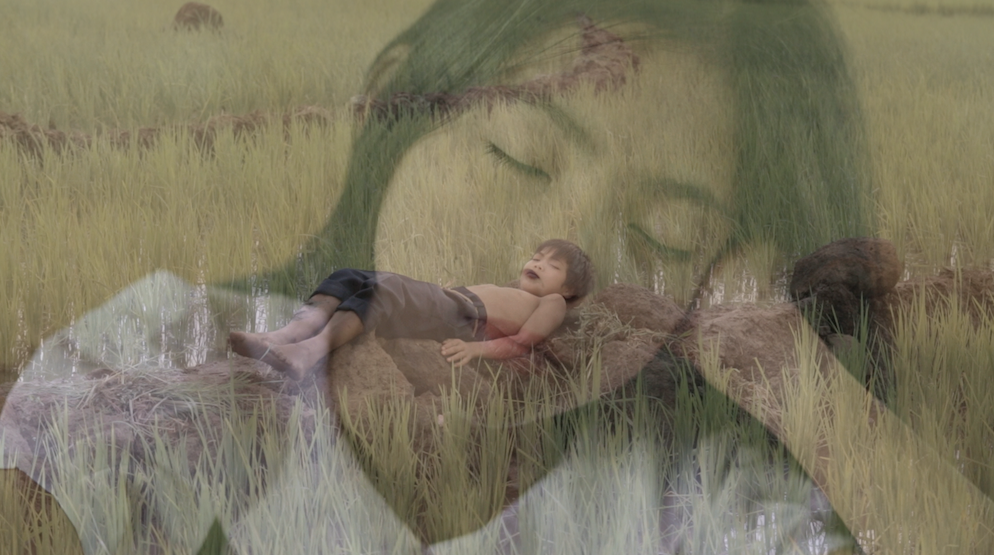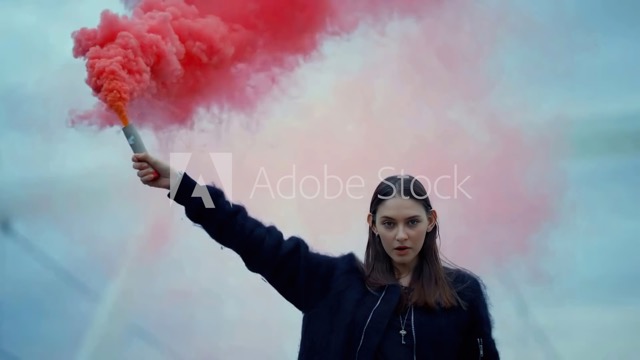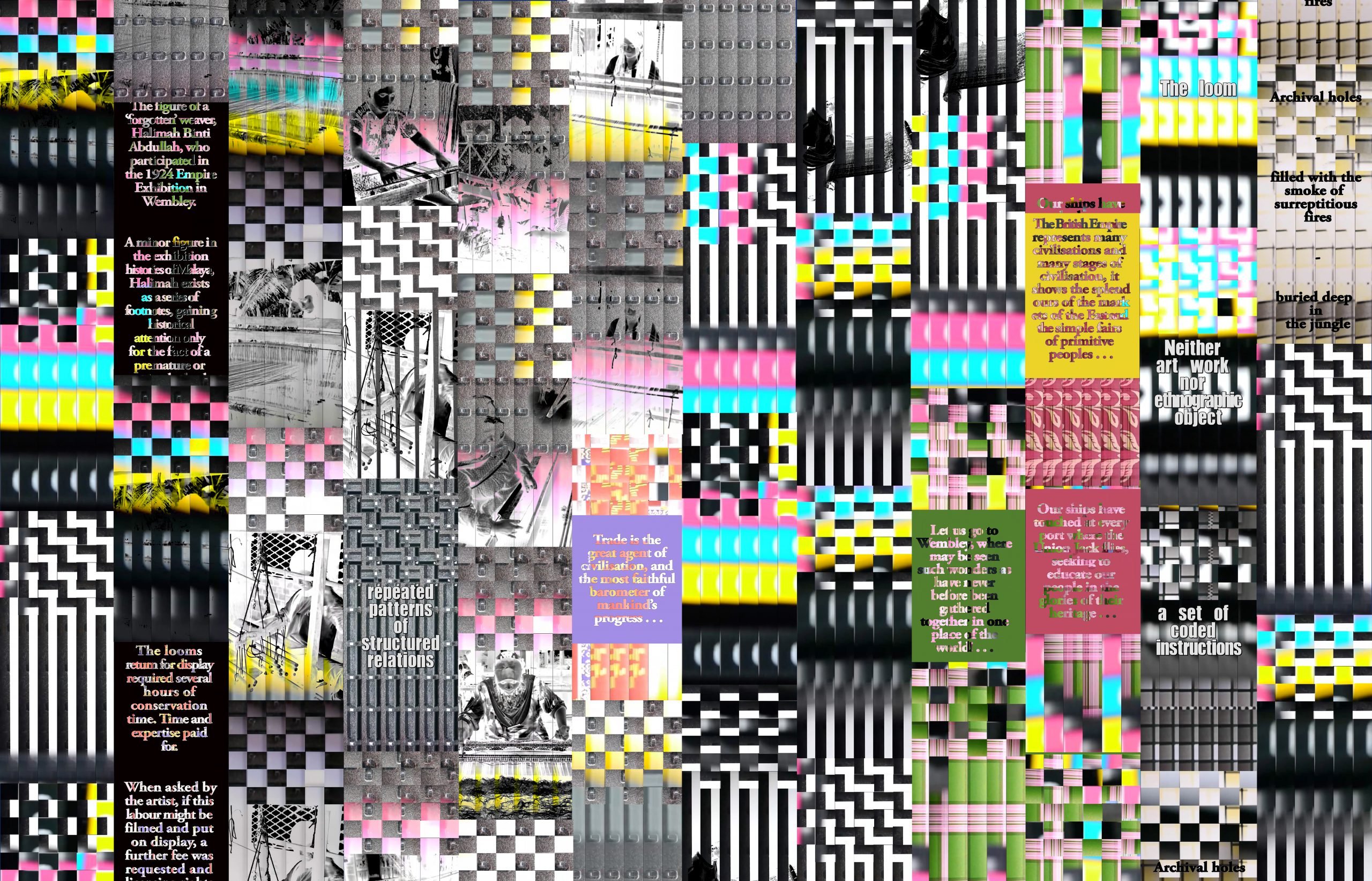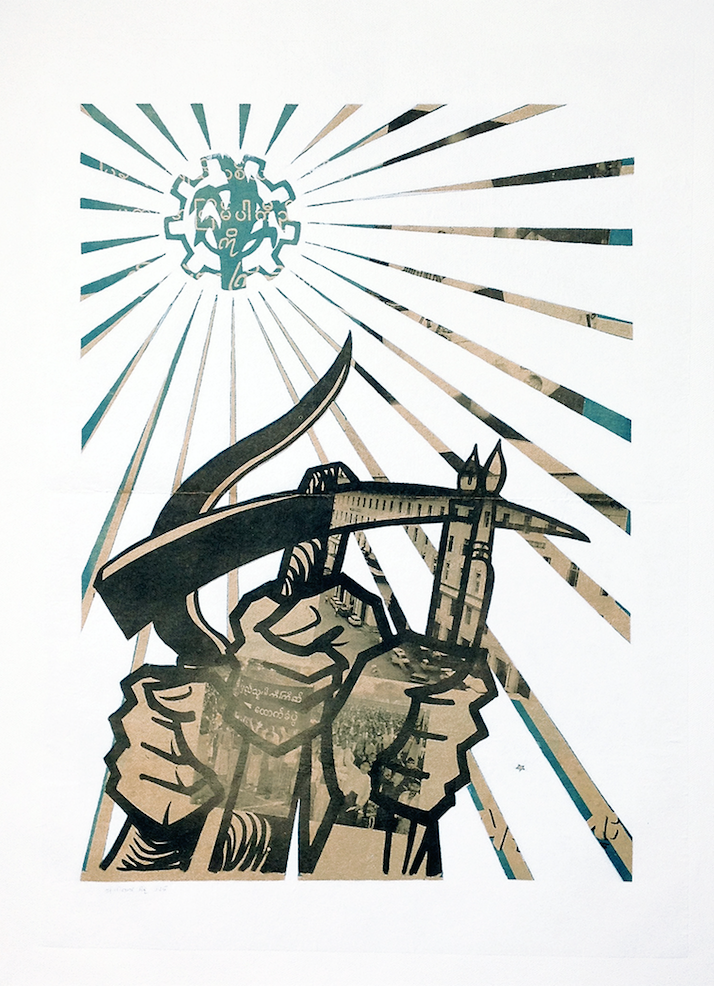
© » KADIST
Nguyen Thai Tuan
In the “Black Paintings” series, although the human body is only suggested, it plays an important role. Some body parts are absent, mostly the faces which are usually an affirmation of the individual. The characters recall ghosts testifying as to the traumas of war.

© » KADIST
Phan Thao Nguyên
On September 22, 1940 the French signed an accord, which granted Japanese troops the right to occupy Indochina. The Japanese presence in Indochina lasted until the end of World War II and during the occupation, jute supplies from India were interrupted. Jute was used to make sacks as well as gunpowder, a crucial material for the war industry.

© » KADIST
Nguyen Trinh Thi
The essay film How to Improve the World by Nguyen Trinh Thi takes us into an indigenous village of the Jrai people in the Central Highlands of Vietnam, in Gia Lai province. It begins with sound – perhaps a hammer, or a gong – the lack of image making its identification difficult. A landscape emerges of an open field where a farmer tends his grazing cow herd.

© » KADIST
Nguyen Trinh Thi
Landscape Series no. 1 presents landscape as a “quiet witness of history.” It began with searches of online archives of Vietnamese news-media, for images of figures in landscapes “pointing, to indicate a past event, the location of something gone, something lost or missing.” The uniformity is striking but the sequence is subtly structured: the typology hints at narrative progression, though of an uninformative narrative, lacking details.

© » KADIST
Tuan Andrew Nguyen
This work presents the image of an immolated monk engraved on a baseball bat. The flames surround him eroding the extremity of the bat. The delicate sculpture refers to the sacrifice of the Buddhist monk, Thich Quang Duc, who immolated himself on June 16th 1963, in reaction to the discrimination and the repressive politics of the Diem Catholic regime (regime installed by the Americans) towards the Buddhists.

© » KADIST
Phan Thao Nguyên
Tropical Siesta begins in a rural landscape of Vietnam. Very quickly, painted images of students sleeping on their school benches appear. A text speaking of how the communist regime has placed agriculture at the center of its economy reads alongside the images.

© » KADIST
UuDam Tran Nguyen
Like many Asian countries, Vietnam has lost an immense amount of natural environment and rural landscape to economic growth and industrial development. The single-channel video Waltz of the Machine Equestrians is a response to the overwhelming number of motorbikes and scooters overtaking the streets of Vietnam as small agrarian communities have been displaced by the construction of skyscrapers. The video shows 28 “equestrians” on motorbikes and scooters arrayed into a rainbow cavalcade held together by strings clipped onto brightly colored ponchos.

© » KADIST
Charwei Tsai
Charwai Tsai’s photograph documents her Hermit Crab Project installation upon the construction site of gallery Sora in Tokyo. Tsai placed live hermit crabs and shells in a sandy enclosure at the site, writing fragments of The One China policy and the Taiwanese Independence statements on each shell. As the hermit crabs moved and swapped shells, they formed new connections between the statements.

© » KADIST
Shen Yuan
Through a seemingly haphazard layering of glass and porcelain, Dérive is part of a larger installation series that address borders and displacement. Sheets of glass and porcelain, two transformational materials of alchemy, are stacked loosely in the shape of melting glaciers that places humans, animals, and nature in the same ecosystem. Migrations of one population into another and the subsequent displacement is emphasized in sharp, jagged edges of the transparent glass—phantasmagoric dreams of a distant place—the migration of not simply physical bodies but also that of political opinions and thoughts.

© » KADIST
Juan Obando
They/Them by Juan Obando is a video essay and deepfake that uses Adobe Stock clips, maintaining their branded watermark, but animating the scenes underneath with a narrative of self-critical awareness. It’s a meta-narrative that uses the staged scenarios (as evidence) to talk about the variable politics (and mercenary capitalism) of the stock footage industry and the misinformation dilemma we’re facing with the arrival of AI technology. In a surprising reversal, a deepfake is used to tell the truth.

© » KADIST
Juan Araujo
Drawing & Print (Drawing & Print)
Many of Araujo’s works depict reproductions and Libro Ponti II is a recreation of a book on Italian architect Gio Ponti. Ponti designed the Villa Planchart a private, modernist house in Caracas, Venezuela, which at the time it was built in 1956, reflected the emergence of a class increasingly globalized, both culturally and economically. Araujo’s replica of the book thus refers to the role and visibility of Venezuela in circuits of global cultural production.

© » KADIST
Guan Xiao
David is a five-minute pseudo music video that features an upbeat melodic soundtrack with a duet by the artist Guan Xiao and frequent collaborator (and KADIST collection) artist Yu Honglei. Three screens display a collection of home videos filmed and uploaded by tourists at the Galleria dell’Accademia in Florence capturing Michelangelo’s eponymous masterpiece. The mass popularity and commodification of this artwork is further exaggerated with the numerous forms that we encounter and consume the image or likeness of the sculpture in our daily lives.

© » KADIST
Juan Capistran
The Breaks reflects Capistran’s interests in sampling and fusing different cultural, social, and historical sources. Growing up in an African-American community in Los Angeles, Capistran has long been influenced by hip-hop culture. The photographs in this print document him surreptitiously breakdancing on Carl Andre’s iconic lead floor piece after the guards at the Los Angeles County Museum of Art have left the gallery.

© » KADIST
Euan Macdonald
The video 9000 PIECES by Euan Macdonald was filmed at a musical instrument factory in Shanghai where 90 percent of the pianos that they manufacture are exported around the world, and only 10 percent are “finished” and can be labeled “Made in the US (or) Europe.” The video captures an intricate network of mechanisms as they interact with each other, their rhythmic movements resulting in an intense choreography and a cacophony of metallic sounds dramatized by Macdonald’s editing. As the shot widens it reveals the process we see unfold: a piano being vigorously tested by a factory machine designed to determine the endurance of the instruments. Contrary to what is often relayed, the work has nothing to do with Chinese factories or fast changing global economies.

© » KADIST
Juan Covelli
El Salto (The Jump/The Waterfall) by Juan Covelli depicts the Salto de Tequendama, a waterfall located on the outskirts of southwest Bogota. During the 19th and 20th centuries, the waterfall served as a national symbol that captured both the singularity of its geographical reference point, as well as the romantic experience of nature and immensity. The video installation arises from a detailed archive research into historic representations of Colombian landscape and reflection on their role in the present-day imaginary of the country and the wider world.

© » KADIST
Nguyen 'Quoc' Thành
A Soldiers’ Garden by Nhà Sàn Collective is a night portrait series located in an army camp outside Hanoi. Here new recruits assemble for basic training during the first months of their military service, before they are relocated to their assigned battalion. Night is the only time the soldiers in training have a few moments for themselves.

© » KADIST
Nguyen 'Quoc' Thành
A Soldiers’ Garden by Nhà Sàn Collective is a night portrait series located in an army camp outside Hanoi. Here new recruits assemble for basic training during the first months of their military service, before they are relocated to their assigned battalion. Night is the only time the soldiers in training have a few moments for themselves.

© » KADIST
Nguyen 'Quoc' Thành
A Soldiers’ Garden by Nhà Sàn Collective is a night portrait series located in an army camp outside Hanoi. Here new recruits assemble for basic training during the first months of their military service, before they are relocated to their assigned battalion. Night is the only time the soldiers in training have a few moments for themselves.

© » KADIST
Diane Severin Nguyen
To produce her photo and film works, Diane Severin Nguyen makes amalgam sculptures from found materials, both natural and synthetic. She captures these ephemeral constructions at close range, enlarging minute tensions. Nguyen uses transient, prosthetic lighting—the glow of sunset, an iPhone flash, battery-powered LEDs, fire—so that the camera intervenes moments before these temporary arrangements and their lighting change.

© » KADIST
Jun Nguyen-Hatsushiba
Filmed underwater, this is the third video in Nguyen-Hatsushiba’s “Memorial Project” series which began in 2001. The title already implies the cultural complexities about to be ironically unravelled: Ho Chi Minh is parodied and Okinawa (where this was filmed) was a battle site in Japan during World War II which then became an American training base during the Vietnam War. To a remix of James Bond movie tracks composed by Quoc Bao, no less than thirty divers in wet suits and full gear advance against the water resistance armed with cartridges of color.

© » KADIST
Xu Tan
Drawing & Print (Drawing & Print)
Biennale, Dog is an appropriation of the posters made to promote biennial art exhibitions. Displayed alongside the official marketing materials of biennials (Shanghai, Berlin, Venice, etc.) Xu’s works provide a satiric and provocative alternative to the official system and make publicly visible images of many realities.

© » KADIST
Juan Capistran
White Minority , is typical of Capistran’s sampling of high art genres and living subcultures in which the artist subsumes an object’s high art pedigree within a vernacular art form. Here, Capistran humorously remixes the form and style of Frank Stella’s Black Paintings with California punk rock band Black Flag’s song title and logo (created by artist Raymond Pettibon). White Minority , then, appropriates, recontextualizes, and riffs on language and visual signs to unmoor notions of identity, power, and revolution.

© » KADIST
Juan Araujo
Residencia Milan 1 is a painting of a house surrounded by lush forest. The image depicted is both photorealistic and creates the illusion of an unfolded piece of paper, with creases and discolorations. In referring to the circulation of images, the painting raises questions of a viewer’s relationship to the image of a beautiful house: as icon, wish, or standard of beauty.

© » KADIST
Guan Xiao
Mixed clips from her collection of thousands of images found online, the three-channel video Weather Forecast is an inquiry into the necessity of a physical movement (a travel) for our identity to transform or change. The question “Why can’t we view Europe from a chair?” periodically punctuates the video, suggesting that a similar personal transformation could occur by experiencing a place through the Internet and staying in the same place. Few episodes appear, each being a transformation process in itself, either by correlation, juxtaposition, combinations of specific matters such as iconography, texts, landscapes, events.

© » KADIST
Juan Capistran
The 10 $1 bills that make up From a Whisper to a Scream (2012) read like instructions in origami. From left to right, each bill is progressively folded up, step by step, into the shape of a gun. Both a scream and a whisper are capable of conveying the same content, if at drastically different decibels, the artist proposes.

© » KADIST
Kan Xuan
In Kan Xuan’s four-channel video Island , a series of objects like nail clippers, hairbrush, toothpaste, and house decorations are shot in close-ups. These highly polished and aestheticized images create a poetic visual flow. However, in front of each object lies a coin of different value—two yuan, one pound, one euro, one dollar—that silently reveals the material value of the household supplies.

© » KADIST
Juan Brenner
The photographic series Tonatiuh (The Son of the Sun) by Juan Brenner is an in-depth visual study of current Guatemalan society from the perspective of miscegenation and the incalculable consequences of the Spanish conquest. Establishing Spanish conquistador Pedro de Alvarado as a central figure, not only in the conquest of Guatemala, but also in the formation of a complex, segregated society, Brenner proposes a series of images that re-establish the lens through which to consider both a historical and contemporary Guatemala. Tonatiuh is a visual essay on the state of a country on the verge of failure and its incapacity to address its own history and learn from it.

© » KADIST
Juan Carlos Alom
In Amantes (Lovers) Juan Carlos points his lens at his own environment, his underground (literally) studio in Havana. A beautiful and intimate image of a seedy yet casual scene of two lovers in the background foreshadowed by a beautiful young woman smoking a joint in the foreground, a very powerful and not too subtle political representation of the current realities and truth of youth life in Havana. Juan Carlos Alom is an artist known for his documentary photography of Cuba’s subcultures and underground scenes.
Juan Araujo
- year born: 1971
- gender: male
- nationality: Spanish
- home town: Caracas, Venezuela
Juan Capistran
- location: Los Angeles, California
- gender: male
- nationality: Mexican American
- home town: Guadalajara, Mexico
Guan Xiao
Guan Xiao is known for her videos composed primarily of found images and videos and her sculptures that explore the logic by which things relate to one another...
Diane Severin Nguyen
Diane Severin Nguyen collects found objects and organic matter to craft the images in her photographs and video works...
Erika Tan
Erika Tan’s practice is primarily research-driven with a focus on the moving image, referencing distributed media in the form of cinema, gallery-based works, Internet and digital practices...
Nguyen Trinh Thi
Nguyen Trinh Thi is a moving image pioneer, not only within the landscape of contemporary art in Vietnam, but also broader South East Asia...
Xu Tan
- location: Amsterdam, Netherlands
- year born: 1966
- gender: female
- nationality: Dutch
- home town: Pekan Baru, Indonesia
Jun Nguyen-Hatsushiba
- location: Vietnam
- year born: 1968
- gender: male
- nationality: Japanese-Vietnamese
- home town: Tokyo, Japan
Shen Yuan
Shen Yuan studied Chinese painting at the Zhejiang Academy of Fine Arts as the first group of students admitted after the Cultural Revolution...
Nguyen Phuong Linh
Phuong Linh Nguyen’s multidisciplinary practice spans video, sculpture and installation...
Charwei Tsai
- location: Taipei, Taiwan
- location: Paris, France
- year born: 1980
- gender: female
- nationality: Taiwanese
- home town: Taipei, Taiwan
Juan Covelli
Juan Covelli uses technology as a medium;, striving to decolonize the museum through digital practices, he releases archives from institutional control for the sake of emancipation...
Juan Brenner
Born and raised in Guatemala, photographer Juan Brenner spent ten years in New York City working in the fashion industry before returning to his home country in 2008...
Tun Win Aung and Wah Nu
Wah Nu and Tun Win Aung, respectively born in 1977 and 1975, Yangon, Myanmar...
Tan Zi Hao
Tan Zi Hao is a multi-disciplinary artist who works predominantly with installation and performance art...
Juan Obando
As a Colombian who studied and now lives in Arizona, Juan Obando has a non-native perspective on the media-obsessed culture of the US...
Nguyen Thai Tuan
Nguyen Thai Tuan was born in 1965, he studied at the school of Fine Arts of Hue where he studied propaganda art, which he got bored of very quickly...
Tuan Andrew Nguyen
Tuan Andrew Nguyen is an artist and filmmaker, one of the three founders of The Propeller Group created in 2006...
Euan Macdonald
Euan Macdonald’s videos, drawings and sculptures are informed by a wide array of philosophical, musical, and literary references, but return repeatedly to the quotidian occurrence, the everyday as subject...
Thu Van Tran
Thu Van Tran grew up in the paradox of the dismantlement of the French colonial empire in Vietnam...
Ho Tzu Nyen
- location: Singapore
- year born: 1976
- gender: male
- nationality: Singaporean
- home town: Singapore
UuDam Tran Nguyen
- nationality: Vietnamese
-
2000-2009
Xu Tan
Drawing & Print
2000(Drawing & Print) Shanghai Biennale, Awaiting Your Arrival is an appropriation of the posters made to promote biennial art exhibitions...
Juan Capistran
2002The Breaks reflects Capistran’s interests in sampling and fusing different cultural, social, and historical sources...
Jun Nguyen-Hatsushiba
2003Filmed underwater, this is the third video in Nguyen-Hatsushiba’s “Memorial Project” series which began in 2001...
Xu Tan
Drawing & Print
2003(Drawing & Print) Biennale, Dog is an appropriation of the posters made to promote biennial art exhibitions...
Juan Capistran
2005White Minority , is typical of Capistran’s sampling of high art genres and living subcultures in which the artist subsumes an object’s high art pedigree within a vernacular art form...
Juan Araujo
Drawing & Print
2006(Drawing & Print) Many of Araujo’s works depict reproductions and Libro Ponti II is a recreation of a book on Italian architect Gio Ponti...
Nguyen Thai Tuan
2008In the “Black Paintings” series, although the human body is only suggested, it plays an important role...
Charwei Tsai
2008Charwai Tsai’s photograph documents her Hermit Crab Project installation upon the construction site of gallery Sora in Tokyo...
-
2010-2019
Euan Macdonald
2010The video 9000 PIECES by Euan Macdonald was filmed at a musical instrument factory in Shanghai where 90 percent of the pianos that they manufacture are exported around the world, and only 10 percent are “finished” and can be labeled “Made in the US (or) Europe.” The video captures an intricate network of mechanisms as they interact with each other, their rhythmic movements resulting in an intense choreography and a cacophony of metallic sounds dramatized by Macdonald’s editing...
Tun Win Aung and Wah Nu
2011Tun Win Aung and Wah Nu initiated the series 1000 Pieces (of White) in 2009, as a way to produce objects and images as a portrait of their shared life as partners and collaborators...
Ho Tzu Nyen
2011The Cloud of Unknowing (2011) is titled after a 14th-century medieval treatise on faith, in which “the cloud of unknowing” that stands between the aspirant and God can only be evoked by the senses, rather than the rational mind...
Tuan Andrew Nguyen
2012This work presents the image of an immolated monk engraved on a baseball bat...
UuDam Tran Nguyen
2012Like many Asian countries, Vietnam has lost an immense amount of natural environment and rural landscape to economic growth and industrial development...
Nguyen 'Quoc' Thành
2012A Soldiers’ Garden by Nhà Sàn Collective is a night portrait series located in an army camp outside Hanoi...
Nguyen 'Quoc' Thành
2012A Soldiers’ Garden by Nhà Sàn Collective is a night portrait series located in an army camp outside Hanoi...
Nguyen 'Quoc' Thành
2012A Soldiers’ Garden by Nhà Sàn Collective is a night portrait series located in an army camp outside Hanoi...
Juan Capistran
2012The 10 $1 bills that make up From a Whisper to a Scream (2012) read like instructions in origami...
Juan Carlos Alom
2012In Amantes (Lovers) Juan Carlos points his lens at his own environment, his underground (literally) studio in Havana...
Nguyen 'Quoc' Thành
2012A Soldiers’ Garden by Nhà Sàn Collective is a night portrait series located in an army camp outside Hanoi...
Nguyen 'Quoc' Thành
2012A Soldiers’ Garden by Nhà Sàn Collective is a night portrait series located in an army camp outside Hanoi...
Nguyen 'Quoc' Thành
2012A Soldiers’ Garden by Nhà Sàn Collective is a night portrait series located in an army camp outside Hanoi...
Nguyen 'Quoc' Thành
2012A Soldiers’ Garden by Nhà Sàn Collective is a night portrait series located in an army camp outside Hanoi...
Nguyen 'Quoc' Thành
2012A Soldiers’ Garden by Nhà Sàn Collective is a night portrait series located in an army camp outside Hanoi...
Phan Thao Nguyên
2013On September 22, 1940 the French signed an accord, which granted Japanese troops the right to occupy Indochina...
Tan Zi Hao
2013Tan Zi Hao produced Pest Control 1110, 709, 428 (or, a Myth for Another) , in response to the Bersih social movement, that catalyzed three rallies on 10th November 2007, 9th July 2011 and 28th April 2012, respectively, to demand a clean electoral roll...
Thu Van Tran
2014From Green to Orange is a series of silver films immersed in a bath of dye and rust...
Nguyen Phuong Linh
2016Set in the haunting space of an ex-colonial rubber plantation in Central Vietnam, Phuong Linh Nguyen’s film Memory of the Blind Elephant is a tender portrait of the complex economies of interspecies trauma and resilience in the face of continued extraction and destruction...
Juan Brenner
2018The photographic series Tonatiuh (The Son of the Sun) by Juan Brenner is an in-depth visual study of current Guatemalan society from the perspective of miscegenation and the incalculable consequences of the Spanish conquest...
Diane Severin Nguyen
2019To produce her photo and film works, Diane Severin Nguyen makes amalgam sculptures from found materials, both natural and synthetic...
-
2020-2029
Diane Severin Nguyen
2020To produce her photo and film works, Diane Severin Nguyen makes amalgam sculptures from found materials, both natural and synthetic...
Nguyen Trinh Thi
2021The essay film How to Improve the World by Nguyen Trinh Thi takes us into an indigenous village of the Jrai people in the Central Highlands of Vietnam, in Gia Lai province...
Juan Covelli
2021El Salto (The Jump/The Waterfall) by Juan Covelli depicts the Salto de Tequendama, a waterfall located on the outskirts of southwest Bogota...
Juan Obando
2023They/Them by Juan Obando is a video essay and deepfake that uses Adobe Stock clips, maintaining their branded watermark, but animating the scenes underneath with a narrative of self-critical awareness...















